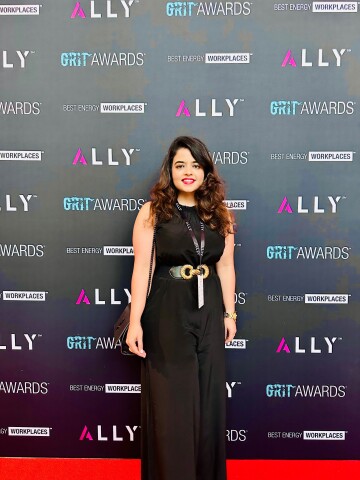Prajakta Kulkarni, SPE, is oilfield services and equipment (OFSE) commercial digital operations leader for Baker Hughes where she has developed and implemented a global digital platform to enhance pricing, strategy, sales, and account management. Prior to identifying the opportunity for digital transformation in the oil and gas industry, Kulkarni built a successful career as a petroleum engineer. In 2012 she joined Baker Hughes as a lead field engineer in India. Working on complex exploration and production projects, she improved operational efficiencies and increased revenue for major energy company clients. Then, as account manager, she pioneered new technologies and led a large team in designing more than 50+ offshore vessel stimulation jobs, unconventional plug-and-perf operations, delivering the project with zero incidents and zero nonproductive time.
Kulkarni holds a BEng degree from Maharashtra Institute of Technology in Pune, India, and completed the Global Energy Leadership Program at Rice University. In 2023 she was recognized as an ALLY Energy GRIT Award finalist for her professional work that is making a change in the energy industry.
EW: You achieved significant success as a petroleum engineer, which can be a particularly challenging field environment for women. Yet, while bearing responsibility for multinational technical projects and commercial management, you expanded your scope to create digital transformation in the oil and gas (O&G) industry. How did you come to observe the digital gap in O&G? What inspired you to take a data-driven approach to pricing agreements?
PK: I moved to the UAE from India in 2018 to manage an unconventional frac campaign for TotalEnergies and work on tenders which were handled by the region. I supervised the complete end-to-end-project for them, and while doing that I learned various aspects of the project, such as handling multiple stakeholders, leading people, and defining various product and service value propositions. I saw that every technology we proposed to the client should be cost-effective and able to fit into their budget.
During this period, I worked on many tenders and when I did the pricing strategy for them, I always struggled to get accurate pricing in that country or region for the products and technology we sold. It was difficult to get critical information on time, such as what we had previously quoted to the customer or what kind of upsell we accomplished outside of our contract—not because the company didn’t have the data, but because the data was scattered among someone’s computer files or existed only in a salesperson’s brain. Obtaining the data was a time-consuming manual process. This pricing strategy was very important for executives, and I was often asked about how we came to a price, and if it was competitive enough to get business. There was no firm answer to this question because it was not backed by research or the data to prove it.
This gave me the idea of having centralized data for all the contracts and products. With a single click the tender manager should be able to pull all the products and past pricing for that customer or account. The tender manager should map where we stand with our competition. This can only be achieved if we have a centralized contract repository with pricing for each line in the contract, linked to invoicing. That’s how the digitalized contract price management platform was generated. I presented the idea and need for the application. The idea was then turned into a project and tied to our overall transformation goals. My objective was to improve sales and commercial efficiency, and our win rate for tenders. I also aimed to include market intelligence for the most important companies under our umbrella. The project was designed to bring all this data under one roof and connect it to our current business systems.
EW: How are your initiative and product platforms changing the way you develop sales strategies for Baker Hughes? What differentiates your digital approach from the traditional way this work was performed?
PK: The digitalized pricing product I developed is the platform that centralizes all contractual and quote-based pricing. This is focused to enable my internal customers, such as sales, commercial organizations, and executives, to make better data-driven decisions based on real market value. Before we created the digitalized pricing platform, we lacked this detailed data, and the tenders were strategized using Excel spreadsheets, without having a full understanding of the market. The user never had such a database to investigate and make informed decisions about how to sell value to the customer.
To solve this problem, the pricing platform we developed is a unique approach to connect each customer’s enterprise resource planning and pricing data. A user can now examine how products have been priced in various regions. Executives can see how the product portfolios are being managed and are performing in different regions. Product leaders can track inventory and supply/demand more efficiently. New salespeople can learn quickly how a market is performing, what we are charging to any customer and go to market strategy for sales. The platform also controls price leakage or revenue underreporting, as it is connected to our jobs and invoicing systems.
Centralized data allows integration with other applications, such as a shopping portal for our customers, or reporting monthly usage to our customers with automation. Because the platform connects to Microsoft’s Power BI, we can generate automated reports that drive process improvement and user efficiency by enabling quicker decisions. Users can now access critical data at their fingertips, from anywhere in the world, enhancing our capabilities to generate, strategize, and build cost-effective solutions 10 times faster, and with zero errors. This allows our sales teams to spend more time understanding customer needs, instead of filling out spreadsheets.
EW: Are you using artificial intelligence (AI) and automation tools in your platforms, and if so, how are you using them?
PK: AI offers significant potential for true business transformation. BHC3 AI (BakerHughesC3.ai) is a joint venture alliance leveraging our company’s energy technology expertise with C3 AI’s unique software. These AI technologies can impact all aspects of energy-related operational efficiencies, including improving reliability and reducing downtime, optimizing production, and increasing yield. In my area, we are presently using AI in a few platforms.
EW: Your academic background is in petroleum engineering. How did you pursue and develop the software engineering skills to envision and execute your ideas, and to now manage teams of IT professionals?

PK: As an experienced petroleum engineer, I already had industry domain knowledge. I was always intrigued about data, and I saw that the energy industry was moving towards digital processes, so I started my journey by exploring various technologies and frameworks to broaden my expertise. I read transformation cases for brands like Amazon, Nike, Airbnb, and Starbucks, and studied their strategies for change management and implementation. I joined a community of product managers from other companies to learn about their strategies and challenges. I attended conferences to know more about the digital space. In my research, I realized that product managers do not need to have advanced coding knowledge, but they do need to be good at visualization, identifying gaps, and developing roadmaps to close those gaps. They should be good at interpreting user stories, so IT professionals can then build a prototype solution and code based on given logic. Problem-solving skills are also very important when you work on any digital product. As a leader, you must know how to clearly map your problem and how you want it to be solved using the software code, and then test it with all cases, so the solution fits perfectly.
I also attended leadership trainings to develop strong communication and interpersonal skills, to effectively lead and motivate teams. I am now part of the change management team, leveraging the right network within the company to foster the adoption of these digital tools and transformation.
EW: You also pursued professional development through Rice University’s Global Energy Leadership program. How have you applied this specialized education in your current role?
PK: The best part of the Rice program was having a cohort from different geographies’ management levels, and companies all working within the energy space. I applied to this program while doing my current job to upgrade myself in energy domain. I met people from CEOs and CFOs to mid-senior managers, startup founders from clients, and service companies who shared valuable insights on what is happening inside their organization or startup space, and how investors think, which helped me understand the energy outlook and evolving landscape.
The program also provided me with a strong foundation in areas including strategic thinking, data analysis, stakeholder engagement, systems thinking, leadership, and collaboration. In particular, the energy management program emphasized data-driven decision making, which has been highly applicable in my current role. I leverage data analytics to inform digital strategies, optimize user experiences, and drive business growth and adoption.
While the program's focus was on energy management, its teachings have been remarkably transferable to the digital space. I've been able to leverage the skills and knowledge gained to drive success in my current role and navigate the ever-evolving digital landscape.
This involved creating a detailed roadmap with milestones, timelines, and resource allocation, ensuring a structured and measurable approach. I encouraged open communication, active listening, and transparency, ensuring every stakeholder felt heard and valued throughout the process. Because I am handling multiple regions and product lines with different business processes, it was important to build in standardization without disrupting their current business.
To do this, I offered targeted workshops, training sessions, and resources to equip stakeholders with the necessary skills and knowledge to support the vision. I recognized and celebrated incremental successes along the way, maintaining momentum and reinforcing the sense of collective ownership. I remained agile and responsive to stakeholder feedback, willing to pivot or adjust the approach as needed to ensure the vision's successful realization.
Finally, I demonstrated my own commitment and enthusiasm for the vision, inspiring others to follow suit and strive for excellence. I established KPIs and regularly assessed the initiative's effectiveness, making data-driven decisions to optimize the approach and drive sustained success. With my team, we built the dashboards in Tableau to track our progress and check if we were on the right path and gave the executive team access to the dashboards to provide transparency that demonstrated the program’s success.
EW: Congratulations on being a finalist in the 2023 ALLY Energy Grit Awards. Tell us about these awards and what they honor. What does it mean to you to receive this industry recognition?

PK: When I started my O&G career, I was working in the remotest oil field in India, and I was the youngest professional female working on that field. But when you have fresh eyes on the field you see things differently, and you try to find unique solutions for those conventional problems. My career journey is somewhat similar, so the GRIT Award recognition means a lot to me. The GRIT Award is a prestigious recognition in the O&G industry that honors individuals who have demonstrated exceptional leadership, innovation, and dedication to the sector. Our industry needs innovative talent to help transform and transition the energy outlook.
When I moved to Houston from the UAE people didn’t know me, but GRIT helped me gain recognition among my peers. It gave me the courage to do better and drive that change. Platforms like GRIT bring professionals together and provide opportunities for innovating and talking to industry experts outside your company. For a mid-management professional like me, it was a steppingstone to making a positive impact in the industry.
EW: From a software engineering perspective, what is unique about the O&G industry, and what do you find missing in the knowledge base of experienced engineers? What do young engineers need to know about technical and professional opportunities in this sector?
PK: O&G operations involve complex processes, such as exploration, production, transportation, and refining. Each of these phases is very different from one another, and each one has different processes and practices. Software engineers are generally unfamiliar with these unique processes, and the highly pressurized systems and safety challenges that O&G field employees work under.
In my experience I’ve seen that the industry is transforming and continuously developing remote operations solutions that allow for minimal human intervention. Examples include remotely operating pumps on frac jobs on offshore rigs, automated drilling for a rig, setting up sensors on equipment to know and track maintenance schedules without human intervention, and innovation in downhole tools so they can withstand higher temperature and pressures.
The industry relies heavily on data analysis to optimize exploration, production, and distribution, making data quality and accuracy crucial, but oilfield service companies and operators have a legacy of older systems, requiring software engineers to integrate new technologies with existing infrastructure.
Operations are global and diverse, demanding software that can scale across different environments and use cases. This is further complicated by the industry’s tech talent gap, so in bridging the gap they are looking for systems which communicate effectively with various platforms and stakeholders.
The industry is now introducing AI, cloud computing, and advanced innovative tools, so to thrive in this industry, the new era of engineers should know more about data and data models and be well acquainted with renewable energy and sustainability.
It will be very interesting to see how the industry uses new technologies to solve old problems.


